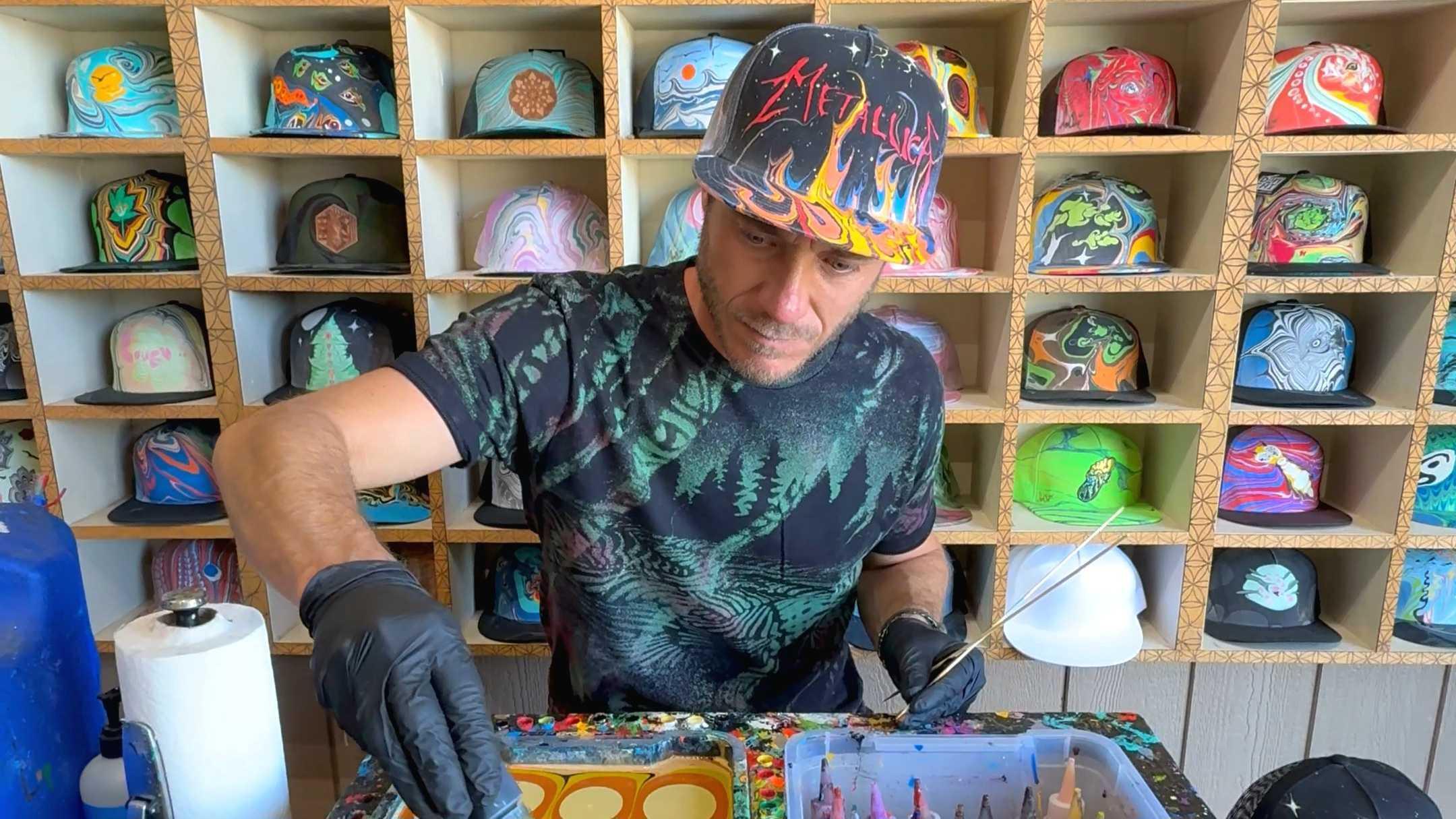
Looking Back on 2025
Some words and photos to look back on the year that was from So What! Editor Steffan Chirazi.
Jun 07, 2022
Ryan Murphy, the artist/sculptor/silversmith/jeweler behind Metallica’s highly popular accessory pieces, including the 40th Anniversary and Vulturus rings, as well as incredible custom guitar parts (which adorn some of James’ and Kirk’s axes), is certainly one of the more cheerful people you’ll speak with over the course of a day. Raised in Southern California but based in Nashville, TN, for the past nine years, Murphy has managed to create a bespoke business, Silver Luthier and with it, an exploding reputation as the creator of quality pieces with a little extra flair and style. Let’s just state clearly that Murphy has a wide selection of pieces that will appeal to all lovers of silver-clad rock’n’roll sensibilities.
Murphy’s pathway started with a childhood fascination with all things mechanical. Along with his keen desire to be a guitarist, Ryan continued with high school carpentry and eventually apprenticed under a third-generation master jeweler in LA, where Silver Luthier’s roots were born. Murphy felt there was little in the way of exciting and interesting guitar hardware (toggle plates, tailpieces, volume and control knobs), which as a guitarist, was rather unsatisfying. Cue a new kind of Murphy’s Law coming into effect, and some key guitars in rock getting a rather tasty “parts” upgrade thanks to his silver creations. Growing up a fan of the Black Album (and, of course, Metallica) as well as Nirvana, early Stone Temple Pilots, Bush, Tears for Fears and Peter Gabriel, let’s learn a little more about Murphy, courtesy of the man himself.
CHILDHOOD
I liked taking my toys apart as a kid and trying to put ’em back together, like remote control cars. Figuring out how the servos would work, that kind of stuff. Just getting a grip on mechanics and how things work. I used to make these little inventions when I was a young kid; I made one where you’d pull a string, and it would go through a series of loops and holes before a little hammer would ring the doorbell. For the most part, I was a pretty good kid, but… I did like playing with matches.
We had this little circular driveway at my house, there was this huge bush in the middle, and I had a little hideout in there. One morning, my dad came to me and said, “Ryan, were you playing with matches in the bush out front?” I said, “Uh, yeah, I guess so. Why?” He said, “Well, when I came home from work last night, the whole thing was on fire. I had to put it out!!!” Oh, shit! I was lucky it didn’t become something worse.
CARPENTRY GATEWAY INTO LUTHIERISM (as in guitar making, not religious conversion!)
When I was 14 years old, I got started in construction work as a carpenter. I had all kinds of tools, so I did woodworking. I’m also a leftie, so I play left-handed, and when I’d go to the guitar stores, all the cool guitars were right-handed. The left-handed version only came in one color with not as good a hardware and all that stuff, so I started building my own guitars. As I was doing that, I noticed all the hardware was kind of the same, all the knobs were always the same, the tailpieces, the tuners, and I just thought it’d be cool to have some different stuff. I’ve always been a fan of rock and roll style jewelry as well, so it just made sense to start working on guitar hardware.
SKULLDUGGERY?
Skulls? I never used to like skulls so much. Then once I started to carve my first one, it just became fun. I used to go around Melrose Avenue down in LA to all those eccentric little shops with all kinds of weird shit. There was this one shop, I forget what it’s called, but it had all these little bone skulls that people had carved, little skeletons of, for example, a bird in a glass jar, all kinds of weird shit like that, and it was inspirational. I wanted them to be cool, clean guitar parts, but they had to be perfect. Because some of these guitar parts are precise. That was the next main challenge: how to produce these by hand perfectly so they’re good enough for James Hetfield’s guitar. For example, to make that first actual piece, whatever it might be, takes a long time because I’m still a hand sculptor doing it the old way. I hand-carve the skull, then I have to figure out a way to mount it to the tailpiece so that it won’t interfere with strings, posts, or any of that stuff but will still fit perfectly. So, to put one together will take me at least a week to two weeks. In the specific case of a tailpiece, once I’ve created the mold, it takes me one day to produce one tailpiece. I’m in the middle of revamping all my guitar parts, and I’m presently working with somebody on helping me mass produce them so we can get them out there more. For me to make each one by hand is time-intensive, but it isn’t like I want to source out to make thousands or anything like that! Mass producing for me would be hundreds of copies of something that I could sell over the course of six months and maybe get an account with some cool guitar boutiques or something like that.
MAKING A SKULL RING FROM START TO FINISH
I start with a block of wax, just a big chunk of wax. You can carve the basic shape within a few hours, but it’s that last final part of the bell curve that takes weeks and weeks to get all the teeth, the nose, and the jawlines just right. So you whittle away, and it’s weeks’ worth of work for me to get this done just right and make sure it fits on the finger well. It’s one thing to carve a skull, but another to sit on your finger, so you have to have the jewelry balance, so to speak. Then I can make a mold of it and cast it, but that’s still a process, injecting wax into it. If someone wants a size ten and yours comes out of the mold a size 12, you have to resize it a little bit. Polishing it, cleaning it up, and in the silver, each one is hours of work.
I have a rubber mold, and I inject it with wax. I let it cool down, then pull the little wax piece out. I make sure it’s perfectly clean, ready to go, and I mount it on a “tree.” There are six or eight rings on a tree, and I put a steel flask around it so they’re all sitting inside the center of it. Then I pour it full of plaster, the plaster sets up, and I put it in a kiln and bake it all the way up to 1350 degrees so all the wax melts out. This can take about 12 hours to burn out.
That process leaves a perfect negative inside that hot flask. Now the flask is empty of wax. You can see down the holes and see the branches splitting off into the jewelry. Then I take my crucible full of silver, heat that up to my pouring temperature of 1850 degrees, and pour liquid silver into the flask. The silver gets sucked into the flask through a vacuum machine which pulls air through the plaster and sucks all the silver up against the sides of the plaster walls. You let it cool down for about ten minutes, then submerge it (the flask is almost 1000 degrees at this point - it’s cooled down a little bit). So, when you dip it in a bucket of water, it’s just this violent gurgling boiling, and it literally rips the plaster to shreds, pulls it all off, and you pull your tree of new silver jewelry out of the now-empty flask.
SILVER PROPERTIES
I just love silver, and I think I’ve gotten good with it over the years; it’s just like butter for me now. It’s a very special metal. It’s actually antimicrobial and antibacterial. People back in the day used to put a silver dollar in their milk before they had refrigerators because it’d make it last longer as the silver would kill some of the bad bacteria. Then they have colloidal silver you can buy at health food stores. It’s the most thermal conductive metal for heat. It’s also the shiniest metal, being used on film back in the day before we went to digital, of course. You know, the silver halides, that was silver. It has amazing properties; I just love it.
…BUT GOLD & GEMS ARE COMING
Gold’s just been so expensive. I’d rather buy 70 ounces of silver (over four pounds) and do all kinds of stuff than buy one ounce of gold. But I really need to start doing that, so I’m getting into some more gold pretty soon, and I’m about to get a whole new table set up with stone-setting tools in my shop. I’m going to learn to do that and just start expanding into some gold and gemstones, because if you look through my site, you’ll start to realize there’s not too much of that there. That is something I intend to change!
CUSTOM ORDERS FROM THE STARS
Brad Whitford, one of Aerosmith’s guitarists, was walking his dog one day and discovered a roadkilled Armadillo carcass rotting in the hot sun. Most people would have just sneered at it and walked on by, but being an eccentric, legendary, badass artist, he decided to run home, get a plastic bag, and bag up some of this carcass! Well, he brought it to me and asked me to make some type of jewelry with it. “Holy shit!” I thought, but nevertheless, it seemed like something I should tackle, so of course, I gloved up and went to work.
I wound up casting the front claw of this armadillo and, of course, had to add a few of my own embellishments and linkages to get it to hang on a necklace. The end result was pretty awesome! He absolutely loved it and has worn it plenty of times on stage and in photoshoots. He then asked me to make one for his buddy, none other than Mr. Johnny Depp! Of course, I made another one that Brad wound up giving to Johnny, which he has happily worn on many occasions as well!
Don’t wait, go see Ryan’s work for yourself right now at SilverLuthier.com or check out the Silver Luthier section in the Metallica Store.

Some words and photos to look back on the year that was from So What! Editor Steffan Chirazi.

Dominic Padua (aka Dom Chi) does many things very well, including the art of marbling. Steffan Chirazi visits his Sebastopol, CA, studio to learn more.

What you are diving into here is my personal journal with regards to the Back to the Beginning extravaganza. Much of it was written off-the-cuff, and the sheer magnitude of the event means that even now there are still pieces of “thought” swirling in the ether and making brain fall by the hour. These recollections, emotions, and observations are shared reflectively over three separate entries after the event and are split between an initial “post-event download” and then a more chronological reflection on our time in Birmingham…